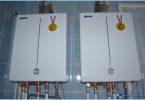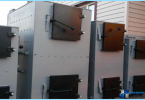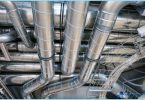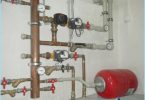The construction of a house is a task in itself difficult. But a special role in the project is heating. Because how well you organize everything and plan depends on the microclimate indoors.
To heat your home with forced circulation worked like clockwork — it is necessary to pay special attention to two things: the choice of materials and installation of the system components. The quality of the used parts depends on the life of the whole structure. One defective valve or the boiler may lead to premature failure.
Quality materials and proper installation of all components and main elements of the scheme heating the house with forced circulation can achieve a long life without repair.
Types of schemes of heating with the forced circulation ↑
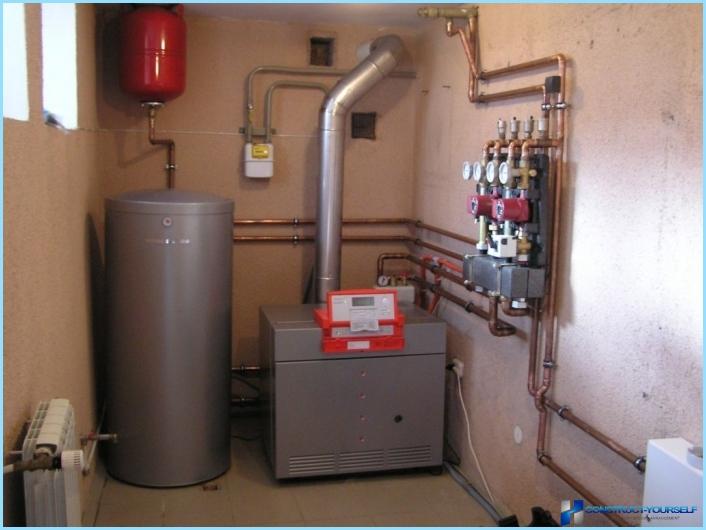
Many owners of country houses still in the process of construction vary in the choice of the type of boiler. Gas equipment is way cheaper, but its operation is much more expensive. That is why most owners prefer schemes home heating with forced circulation.
This pipe does not have to run the water. Moreover, such a coolant has many drawbacks. For example, if you are on winter leave the house unheated, then frozen inside the boiler the water it can seriously hurt. The same applies to the pipes. That is why in modern equipment uses a special coolant, which transfers heat much better and does not freeze.
In fact, the scheme of heating the house with forced circulation has a number of advantages. More precisely, there are three kinds of structures with their pros and cons:
- Monotube,
- collector,
- twin-tube.
On each of this schemes home heating with forced circulation it is necessary to tell separately. You will then be able to choose the best option to install in your home.
One pipe scheme ↑
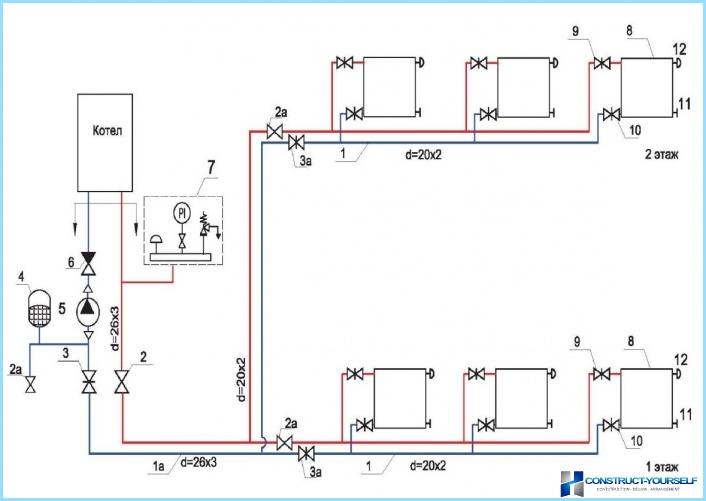
The coolant moves along the two branches. One goes down and the second goes up. Thus, the network fails to ensnare the whole house. A special role in this scheme is the valves. It depends on the possibility of heating the house with forced circulation of coolant. Unfortunately, because it is possible to heat only half of the room.
The bottom two pipes merged into one. This happens closer to the coolant. An important advantage of single-pipe scheme of a private house heating with forced circulation is the ease of connection of radiators. The process is no different from the same in a one-story building.
Valves at the entrance is necessary in order to regulate the heating level. Besides, it is impossible without correct balancing. She also established and output. But here its role is completely different.
The output valves are needed to the heating element in case of breakage can be disconnected from the entire system. This allows you to repair with minimal cost.
If you disconnect the radiator from the General scheme of heating the house with forced circulation by means of valves at the exit, it will allow to avoid draining the coolant. Moreover, even boiler operation stop is not necessary. You will have the opportunity to carry out repairs, without violating the microclimate inside the house.
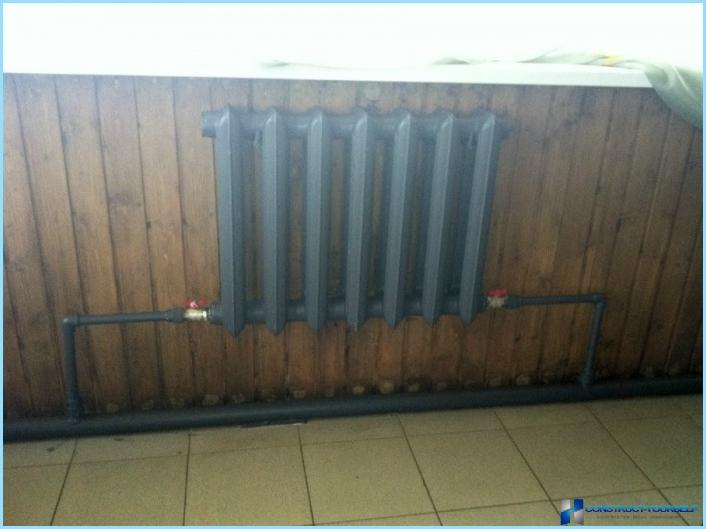
More uniform heating of the room allows you to achieve apply a bypass line. But to carry out installation of the heating elements of the circuit can be possible without it. However, in this case, you will have to install the equipment with different capacity. In addition, you need to understand that this step will lead to the necessity of taking into account the cooling of the coolant.
The fact that each radiator consists of a plurality of sections. Of course, when they are created using different materials with the specific qualities of the conservation and transfer of heat. But despite this General law for all devices single — the farther from the boiler, the greater must be the radiator.
Reducing the number of valves leads to the fact that the scheme heating the house with forced circulation becomes much less maneuverable. Therefore, it is better to consider in advance so that if necessary it was possible to carry out quick repairs.
When choosing a suitable scheme heating the house with forced circulation, note the following advantages of one-pipe system:
- easy to install,
- economic feasibility,
- effective heat transfer,
This is a fairly significant advantages that you should consider when choosing heating schemes, but also do not forget about the shortcomings. The most important is the uneven distribution of heat. Also the disadvantages include the need for balancing.
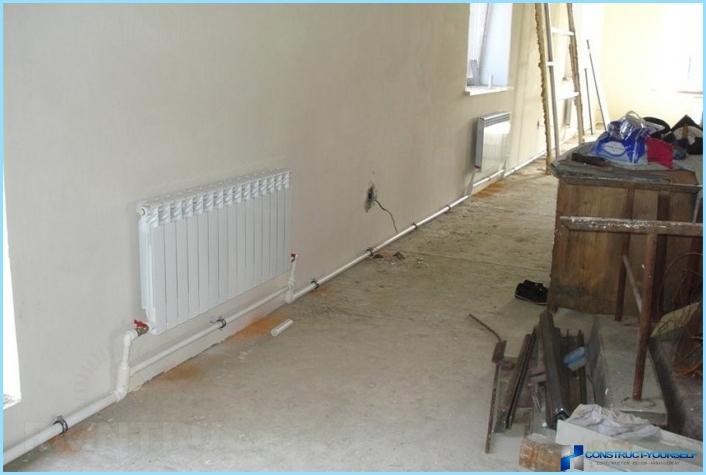
A good example of one pipe scheme heating the house with forced circulation is the so-called Leningrad. In it, the radiators are connected in parallel to the looped tube. This allows you to effectively adjust the heat output of each device. The scheme consists of the following elements:
- the boiler;
- tube through which the coolant passes;
- tank;
- the hydraulic pump;
- radiators;
- return;
- security system;
- drain.
The security system of the Leningrad scheme heating the house with forced circulation consists of a manometer and two valves. One safety, and the second air.
Two-pipe scheme ↑
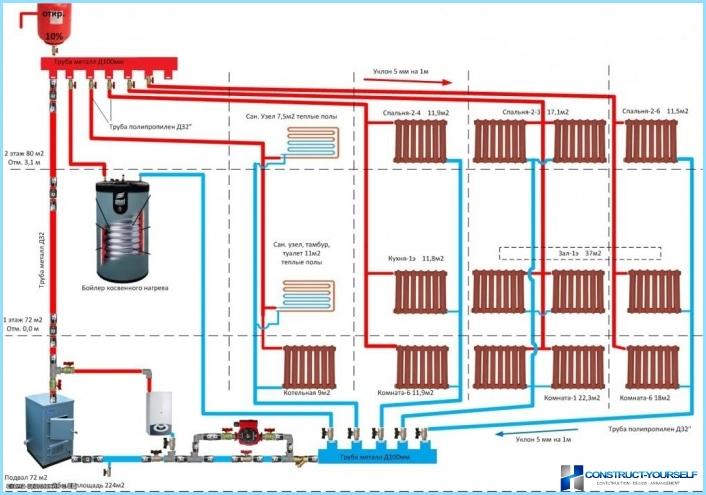
Two-pipe scheme of heat your home with forced circulation gives optimally uniform distribution of heat in contrast to the single tube. Besides its efficiency in times above.
On each radiator there should be trap air. Also need a check valve on the pipe. It allows you to quickly change the intensity of work. To the inside of the pipes was not excessive pressure at the outlet of the radiator valves not installed. The best place for laying pipe shut is the ceiling or place under a window sill.
Unfortunately, and without disadvantages to do not remove. Two-pipe scheme of heat your home with forced circulation requires a lot of costs for installation. The number of pipes is doubled.
Another significant disadvantage is the difficulty in decorating. The pipe is pretty hard to disguise. In most cases they will be evident. Luckily, these disadvantages are spared manifold diagram home heating with forced circulation.
An important feature of two-pipe forced circulation system is that it can be combined with natural. As a result of connections formed design elements such as:
- supply risers,
- tank,
- tube,
- boiler,
- pump,
- binding of the pump,
- crane,
- radiators,
- the return.
Design does not represent special complexity, but it allows you to organize the even distribution of heat around the house, although it is quite material that bounces on the cost.
Manifold diagram ↑
It is believed that this design of heating with the forced circulation is the most perfect, from a technical point of view. Its main feature is that the coolant gets to a pre-manifold.
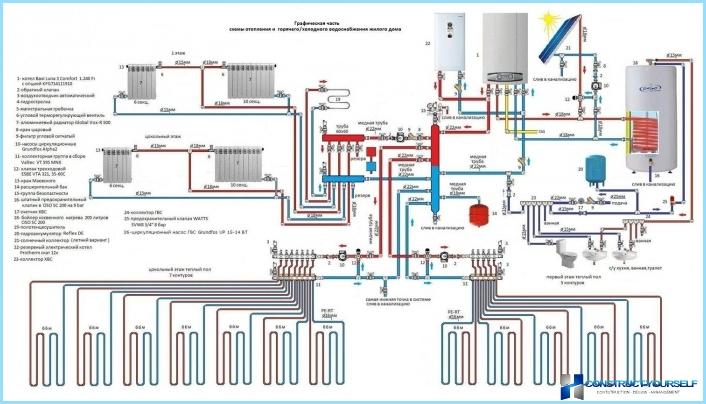
To connect the radiator to the manifold valves is used. Design with header allows you to mount and dismount all components of the heating system with forced circulation without stopping.
The undeniable advantage is ease of management. In addition, there is the possibility to include in the scheme a warm floor. This will not only make the heating more uniform, but will allow you to save on energy. The contours are independent of each other. Therefore, it is allowed to connect to the block of automatic control.
To better understand how the reservoir system is forced circulation, consider a specific example of the structure. It consists of the following elements:
- main tube,
- boiler,
- the return line to the radiator,
- collectors distribution,
- the collectors return,
- the return line to the radiator,
- security system,
- pipe the return,
- pipe,
- filter,
- radiators,
- pump,
- tank,
- drain.
From a technical point of view, this system is forced circulation is quite complex. But even it can be done by hand. Although forces will have to spend much more than the first two options.
What should be the pipe material ↑
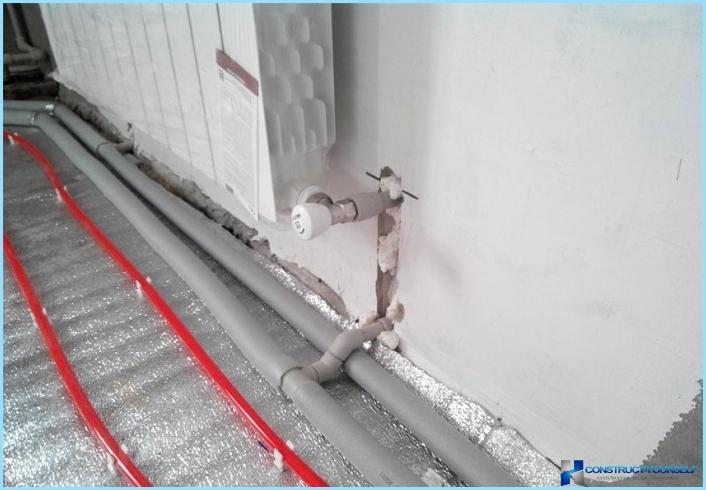
To create a system with forced circulation you can use plastic pipes. Also quite a good material for this problem is the polymer. But if you decide to use PVC, you will need fittings.
If we talk about the best material, the good shows polypropylene. Pipe it is easy to mount, plus they are highly reliable.
The results ↑
Of course, the most technological is the manifold the heating circuit of a two story house with forced circulation. But to create it need to spend a lot of time and money. The low cost is the first option.

